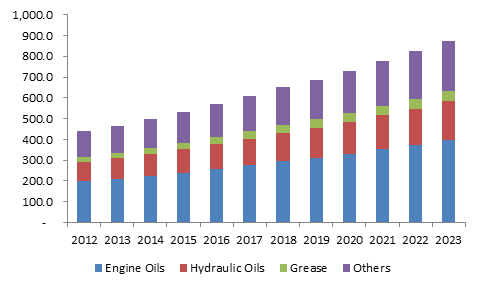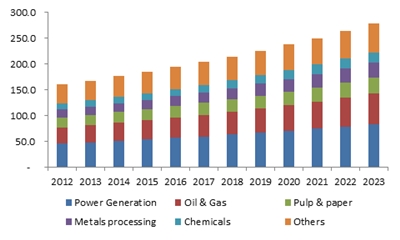The worldwide marine lubricants market was forecasted to expand from more than 2.5 million tons during year 2015 in terms of volume. It is projected to expand at a CAGR growth rate of 3.5% during the estimated period.
Marine lubricants minimize the friction between functional mechanical parts, thus enhancing the productivity of machines, components and engines deployed on the ship. The emerging shipping sector is predicted to boost the growth of the global marine lubricants market in future. But fluctuations in costs of raw materials along with stringent ecological rules for producing synthetic marine lubricants are few of the factors predicted to hamper the growth of the worldwide marine lubricants market.
South America marine lubricants market size, by application, 2012 - 2023 (USD Million)
Technological breakthroughs, freight tax rules and continuous investments in research & development activities are the key factors stimulating the growth of the worldwide marine lubricants market since past few years. This trend is projected to persist and enhance the demand for marine lubricants during the projected span.
Based on the product, the worldwide marine lubricants market was segmented into bio based marine lubricants, mineral oil marine lubricants and synthetic marine lubricants.
The rising occurrence of oil spills has affected marine life. So to avoid oil spills in waters and enhance product quality along with environment security government has introduced strict rules. This has led to rise in demand for bio based marine lubricants and secured synthetic marine lubricants.
Mineral oil marine lubricants section led the product segment of worldwide marine lubricants market during year 2013 in terms of demand. It is projected to continue its domination of the market in future. Technological innovations and growing expenditure on research activities are the key factors stimulating the development & expansion of the mineral oil marine lubricants. The demand for the section is predicted to grow during the estimated period.
Synthetic marine lubricants section followed mineral oil marine lubricants section both in terms of growth in value and size. Growing need for high quality lube grades along with its increasing significance for particular uses are the key aspects driving the growth of the synthetic marine lubricants section.
Rising standards of carbon emissions and increasing gap between demand & supply of products has boosted the growth of bio based marine lubricants section. Bio based marine lubricants section has acquired greater acceptance in the global industry. It is predicted to expand at a significant rate during the estimated period. Further, rising environmental problems and growing consciousness about it among the end users of marine lubricants is predicted to propel the bio based marine lubricants demand.
Depending upon the applications, the worldwide marine lubricants market was divided into compressor oil marine lubricants, gear oil lubricants, engine oil marine lubricants, grease, hydraulic oil marine lubricants, heat transfer fluids and turbine oil marine lubricants.
Engine oil marine lubricants section dominated the application segment of the worldwide marine lubricants market during year 2013. Growing capacity of ship engines and proficiency has resulted in enhanced demand for engine oils.
Engine oil marine lubricants are mainly divided into two types. One is marine diesel cylinder lubricants and trunk piston engine oils.
Marine diesel cylinder lubricants are utilised in two stroke engines of big containers or cargo ships while trunk piston engine oils are utilised for lubrication of four stroke engines of coastal ships & passenger ships.
Hydraulic oil marine lubricants section and grease section followed engine oil marine lubricants sections in its market growth. Hydraulic oil marine lubricants are projected to experience maximum expansion in future. The growing use of hydraulic oil in mechanical components of ships is projected to fuel the hydraulic oil demand during the estimated span.
Based on the geographical location, the worldwide marine lubricants market was segmented into four geographical regions, namely, North American subcontinent, European continent, APAC zone and region of the rest of the world.
APAC zone led the worldwide marine lubricants market during year 2013 in terms of size. This growth was attributed to heavy demand of marine lubricants in developing nations like Japan, China, Singapore and South Korea. The demand for marine lubricants is predicted to grow in Asia Pacific zone owing to various factors like low shipbuilding charges & improved domestic use in country like China.
Request sample research report: https://www.gminsights.com/request-sample/detail/412
Asia Pacific zone is predicted to experience biggest rate of growth during the forecasted period. The growth can be attributed to the several micro & macro economic factors like financial incentives, tax reforms, tax benefits and favourable government policies encouraging many industry players to shift their production units to the highly developing nations like India and China. Further, emission standards in APAC zone are liberal as compared to those in US and Europe. This key aspect also has played a main part in driving the growth of the marine lubricants market in APAC zone.
European continent led the worldwide marine lubricants market during year 2011. The growth of the market in Europe can be attributed to factors like favourable government rules, high level of end user & customer awareness about the product and growing amount of investments for marine lubricants along with increase in amount of seaborne business in Europe. Enhanced economic condition is predicted to have a favourable impact on the growth of the marine lubricants market in Europe in future.
The worldwide marine lubricants market displays the features of oligopolistic market. Key industry players compete with each other for acquiring maximum market share and profits. These industry players implement successful business strategies and invest heavily in R& D activities to expand their business. The industry has experienced many mergers & acquisitions and joint ventures in recent years.
Today, the worldwide marine lubricants market is led by key industry players who have made substantial contributions towards the growth & expansion of the marine lubricants sector.
The key industry players include:
• LubmarineThe key industry players include:
• ExxonMobil Corporation
• Gan & Lee Pharmaceutical
• Royal Dutch Shell PLC
• Gulf Marine And Industrial Supplies Incorporation
• Mars Petrochem Private Limited
• IKO Marine Lubricant Supply Company Limited
• Chevron Corporation
• QUEPET Lubricants
• Sinopec Corporation Limited
• BP Marine
• Castrol
• Pentagon Lubricants Private Limited
• LUKOIL Marine Lubricants Group
• JX Nippon Oil & Engine Corporation
• Gulf Oil Corporation Limited
• Idemitsu Kosan Company Limited


